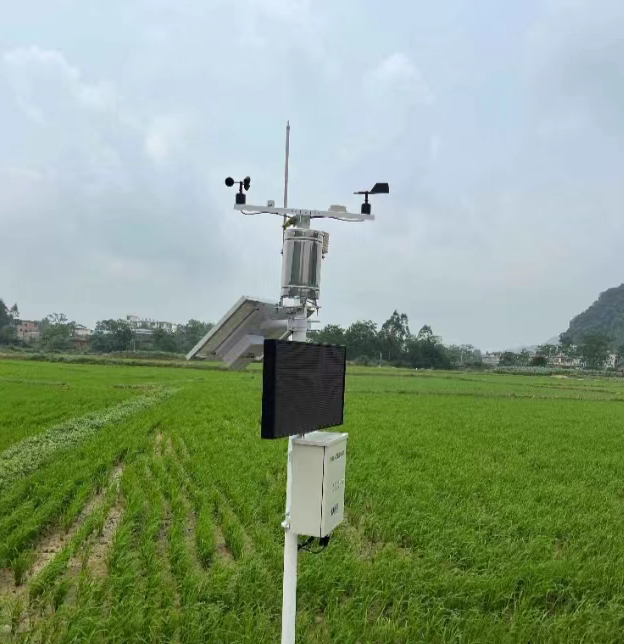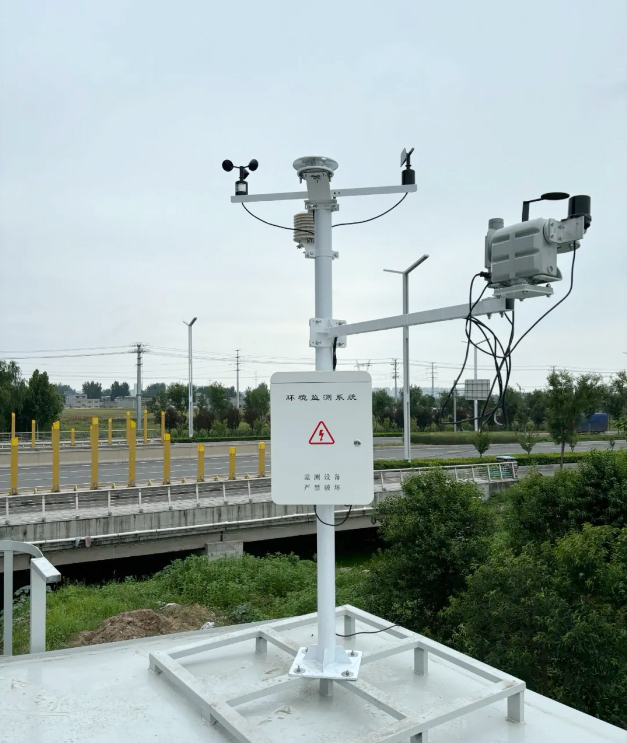

— Blogs —
—Products—
 Consumer hotline +8618073152920
Consumer hotline +8618073152920 WhatsApp:+8615367865107
Address:Room 102, District D, Houhu Industrial Park, Yuelu District, Changsha City, Hunan Province, China
Product knowledge
Time:2024-10-27 16:58:31 Popularity:483
The coverage of a weather station depends on a number of factors, including the type of station, its design, monitoring parameters, environmental conditions and density of deployment. The following is a detailed analysis of the coverage of weather stations:
- Small hand-held or portable weather stations: These weather stations have a relatively small coverage area and may only cover an area of tens to hundreds of square meters. They are usually used for temporary or mobile weather monitoring tasks.
- Large stationary weather stations: These weather stations usually have a much wider coverage area, which can extend to several square kilometers or even more. They are usually used for long-term, continuous meteorological observations and forecasts.
The parameters monitored by a weather station will have an impact on its coverage. The following is a detailed analysis of some common parameters and their coverage:
- Temperature and humidity
- Temperature: Temperature variations are more delicate and influenced by the local environment, and the effective range is usually within a few meters to tens of meters.
- Humidity: The measurement of humidity is also affected by the local environment, and the effective range is usually within a few meters to tens of meters.
- Special environment: Inside the mine, the monitoring range of temperature and humidity may be limited by the size of the tunnel, ventilation conditions and other factors.
- Wind Speed and Direction
- Wind speed: The monitoring range of wind speed depends on the height and installation position of the anemometer. Higher anemometers and reasonable installation locations can provide a wider range of wind speed monitoring, usually within a few tens of meters.
- Wind direction: The wind direction monitoring range is also affected by the height and mounting position of the anemometer, usually within a few tens of meters.
- Complex environments: In complex terrains or areas with a high density of buildings, the monitoring range of wind speed and direction may be impeded, and a denser monitoring network is required to ensure the accuracy of the data.
- Precipitation
- Precipitation: The monitoring range of precipitation usually depends on the size and location of the rain gauge. Larger rain gauges and sensible installation locations can provide a wider rainfall monitoring range, typically within a few meters to tens of meters.
- High Precipitation Areas: In areas of high rainfall, the coverage of the rain gauge may need to be greater to ensure that rainfall data can be accurately recorded.
- Atmospheric Pressure
- Atmospheric Pressure: Atmospheric pressure is a relatively stable parameter and is less affected by the local environment, and the effective range is usually limited to the location of the weather station.
- Special environments: In high mountainous or deep sea areas, atmospheric pressure monitoring may require more specialized equipment to ensure the accuracy of the data.

Environmental conditions such as topography, vegetation cover, building distribution, etc. may also have an impact on the coverage of a weather station. In complex environments, weather stations may require more advanced technical means to ensure the comprehensiveness and accuracy of the monitoring data.
Within the same area, increasing the deployment density of weather stations can expand their effective coverage and improve the spatial resolution and continuity of monitoring data. This helps to capture and record meteorological data more accurately and improve the accuracy of meteorological forecasts.
In special environments such as mines, the coverage of the weather station needs to cover all areas around the mine, including the mining face, the back-mining face, the synthesized mining face, and the construction work area. This helps to monitor all weather data in real time and provide early warning to ensure safe production underground. However, constrained by terrain, economy and other factors, the deployment of mine weather stations may not be perfect, and it is necessary to continuously optimize and upgrade the layout and management mode.

The parameters monitored by the weather station cover many aspects, which are of great significance for understanding the weather conditions, climate change and making weather forecasts, etc. The following are some common parameters monitored by the weather station. The following are some common parameters of weather station monitoring:
- Definition: Temperature is one of the most basic parameters in meteorological monitoring, reflecting the physical quantity of how hot or cold the air is.
- Unit: It is usually recorded in degrees Celsius (℃).
- Impact: Changes in temperature directly affect weather conditions, climate patterns, and ecosystems.
- Definition: Humidity is the amount of water vapor in the air, and has important implications in many areas, including meteorology, agriculture, and ecology.
- Unit: Usually expressed as a percentage (%) of relative humidity.
- Impact: Changes in humidity affect human comfort, meteorological conditions, and various climatic phenomena.
- Definition: Barometric pressure is the force of atmospheric pressure per unit area.
- Units: Usually recorded in hectopascals (hPa).
- Influence: Changes in barometric pressure can indicate changes in weather systems, such as high and low pressure systems.
- Definition: Wind speed is the speed of air movement.
- Units: Usually recorded in meters per second (m/s) or kilometers per hour (km/h).
- Influence: Changes in wind speed affect weather conditions, climate patterns, and air quality.
- Definition: Wind direction is the direction in which the wind blows.
- Units: usually expressed in terms of geographic position (e.g., north, southeast, etc.) or degrees (°).
- Impact: Understanding the major sources and direction of wind flow is critical to analyzing weather patterns and climate change.
- Definition: Precipitation is the process by which condensation of water in the atmosphere falls from clouds to the ground in liquid or solid form.
- Units: It is usually recorded in millimeters (mm).
- Impact: Precipitation data are important for analyzing precipitation patterns and water resource management.
- Definition: Solar radiation is the process by which the energy emitted by the sun is radiated to the earth in the form of electromagnetic waves.
- Units: It is usually recorded in watts per square meter (W/m²).
- Impact: Solar radiation has a significant impact on plant photosynthesis, energy use and climate research.
- Definition: Visibility is the maximum distance at which a target can be observed in the atmosphere.
- Units: Usually recorded in meters (m) or kilometers (km).
- Impact: Visibility data are important for traffic safety, aviation and marine navigation.
- Definition: Soil temperature is the temperature in the soil.
- Units: Usually recorded in degrees Celsius (°C).
- Impact: Soil temperature has an important impact on plant growth, soil microbial activity and groundwater circulation.
- Definition: Soil moisture is the amount of water in the soil.
- Units: Usually expressed as percent by volume (%) or percent by mass (%).
- Impact: Soil moisture has an important impact on plant growth, irrigation management and soil erosion.
- Definition: Evapotranspiration is the amount of water that evaporates from the surface of the ground or water body to the atmosphere.
- Units: Usually recorded in millimeters (mm).
- Influence: Evapotranspiration data have important implications for water resource management and weather forecasting.
Choosing the right location for the installation of a weather station is essential to ensure the collection of accurate and reliable weather data. The following are some considerations to help select the ideal installation location for a weather station:
- Definition: Ensure that the location is representative of the climatic characteristics of the area in which it is located, avoiding the influence of localized microclimates.
- Specific Requirements: Select an area with relatively flat topography and avoid installations near hills, valleys, or buildings, which may cause bias in wind speed and precipitation measurements.
- Definition: Select an area with relatively flat terrain and avoid installation near hills, valleys or buildings.
- Specific requirements: Ensure that there are no obstacles such as trees, buildings, etc. around, which may block wind and sunlight.
- Definition: Consider the soil type as different soil types may affect the measurement of soil moisture and temperature.
- Specific requirements: Select an area with uniform and stable soil types.
- Definition: Consider the climatic characteristics of the area, such as windy, rainy or extreme temperatures.
- Specific requirements: Ensure that the weather station can withstand these conditions.
- Definition: The location should be easily accessible for maintenance and calibration. Specific requirements: Choose a location that is easily accessible.
- Specific Requirements: Choose a location that is easily accessible by public transportation.
- Definition: Ensure that the weather station is installed in a safe area, away from possible risks. Specific requirements: Avoid installing in areas that are vulnerable to risk.
- Specific Requirements: Avoid installing in areas prone to natural disasters (e.g. floods, landslides), away from wildlife or human damage.
- Definition: Consider the reliability of the power supply and the availability of a stable communication network for data transmission.
- Specific requirements: Ensure a stable power supply and choose an area with good communication signals.
- Definition: Avoid sources of pollution such as roads with heavy traffic, industrial facilities or agricultural activities.
- Specific requirements: Select an area away from these sources of pollution.
- Definition: Ensure that the installation location will not change significantly during the expected period of operation.
- Specific requirements: Select areas with stable land use to avoid the effects of urban development or land use changes.
Conclusion
In summary, the coverage of weather stations is a complex and variable issue that needs to be analyzed on a case-by-case basis. The parameters monitored by weather stations will have an impact on their coverage, so when selecting weather stations, a variety of factors such as actual needs, budgetary constraints and environmental conditions should be taken into account to ensure that the selected weather stations can meet the monitoring needs and provide accurate and reliable data support. At the same time, the type of equipment, installation location and density of deployment should be reasonably selected according to the characteristics of the monitoring parameters and the requirements of the coverage area, so as to optimize the monitoring effect of the weather station.
Related recommendations
Sensors & Weather Stations Catalog
Agriculture Sensors and Weather Stations Catalog-NiuBoL.pdf
Weather Stations Catalog-NiuBoL.pdf
Related products
 Combined air temperature and relative humidity sensor
Combined air temperature and relative humidity sensor Soil Moisture Temperature sensor for irrigation
Soil Moisture Temperature sensor for irrigation Soil pH sensor RS485 soil Testing instrument soil ph meter for agriculture
Soil pH sensor RS485 soil Testing instrument soil ph meter for agriculture Wind Speed sensor Output Modbus/RS485/Analog/0-5V/4-20mA
Wind Speed sensor Output Modbus/RS485/Analog/0-5V/4-20mA Tipping bucket rain gauge for weather monitoring auto rainfall sensor RS485/Outdoor/stainless steel
Tipping bucket rain gauge for weather monitoring auto rainfall sensor RS485/Outdoor/stainless steel Pyranometer Solar Radiation Sensor 4-20mA/RS485
Pyranometer Solar Radiation Sensor 4-20mA/RS485
Screenshot, WhatsApp to identify the QR code
WhatsApp number:+8615367865107
(Click on WhatsApp to copy and add friends)